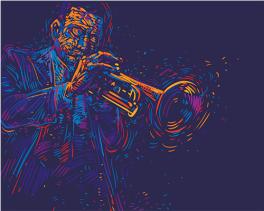
Music 2288
GEL: Visual and Performing Arts (VPA), Social Diversity in the United States (SD)
GEN: Literary, Visual and Performing Arts (LVPA)
Open to music majors and non-majors. No previous musical experience required.
Please consult Class Search to confirm course meeting times, locations and delivery mode.
Course Description
This course was created by Professor Emeritus Ted McDaniel, with the tradition continued by Jason Rawls, assistant professor of hip hop. This course examines the aesthetic and historical evolution of Rhythm and Blues and the Black music tradition including Bebop, Rock and Roll, Doo-Wop and Hip-Hop, redefining American popular culture post-WWII.
The term Rhythm and Blues, simply abbreviated R&B, is used here to refer to the various derivatives of the blues from the 1940s to the present time including the musical styles commonly referred to as soul music, funk, Motown, urban contemporary, Philly Sound, Memphis Sound, Harlem Sound, Rock and Roll, Doo-Wop, Disco, New Jack Swing, rap and hip-hop. Rhythm and Blues, the general term for African American popular music since World War II, melded earlier styles of black music, especially blues, jazz, boogie-woogie, gospel music and harmony singing. R&B launched the two most powerful and influential musical/cultural forces of the last half of the twentieth century, namely Rock & Roll and Rap music, the driving engine of hip-hop culture. In so doing, R&B transformed American culture and has shaped much of the popular culture musical practices in the modern world.
This course is designed for anyone interested in the African American music/cultural experience or the tradition of American popular music and culture from the 1940s. No formal knowledge of music theory or previous background in music is required. The course will provide a survey of the various music styles that make up the genre of Rhythm and Blues. Beginning with big band swing, bebop jazz, social dancing, solo and small-group singing of the 1940s, this course will progress chronologically through the 1950s, 1960s and on through the beginning of the 21st century. Major styles of black social music including early R&B, doo-wop, Motown, soul music and rap will be examined. Emphasis will be placed on a stylistic analysis of the major performers, composers and arrangers, and their practices. Much attention will be given to the social and cultural context (including Africanisms; race, gender and class issues in the United States; themes and influences of music lyrics; music industry practices; urban music and people; radio, television and the recording industry) that nurtured the development of R&B in the postwar environment of the 1940s through the hip-hop culture of the 1990s and beyond. Films, demonstrations, recordings, videos and live performances will supplement the lectures occasionally.
